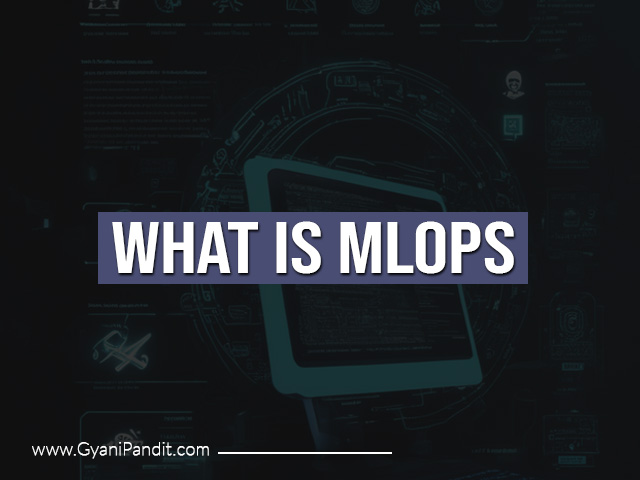If you have come to read about MLOps here, then most probably the term “Machine Learning” is not new to you at all. The field of Artificial Intelligence is gaining a lot of attention and popularity, and along with that, intensive research and advancement are going on in this area, Machine Learning is one of the crucial ways when we are working towards Artificial Intelligence, while there is a lot more in the world of AI.
What is MLOps? A simple Introduction
Through this tutorial, we are going to learn about MLOps or Machine Learning Operations. We will try to keep the explanation as simple as possible so that you can easily digest the information, and learn about MLOps.
What is Machine Learning?
First of all, if you are someone who is not familiar with the concept of Machine Learning, you need to know about Machine Learning before moving any further, because MLOps has it in the name. So, first, let’s quickly understand Machine Learning, and then we will move to understand MLOps.
So, you can easily understand Machine Learning as enabling machines to learn from the data, to make some predictions, or to make decisions, without being explicitly programmed to do so. Machine Learning involves a bunch of techniques, which we are not going to go into detail, but essentially this is what Machine Learning is.
If you want to explore more about Machine Learning, you can read more about it here.
When implementing Machine Learning, we usually create some models, which learn from the data, to make some predictions, or take decisions. This involves a whole bunch of work, like gathering the data, performing some preprocessing on the data, training, then testing the model, and if the model accuracy is great, or enough for your business needs, you deploy the model, and mostly, you may not even get the model to deployment.
Actually what I discussed above is something called a Machine Learning Life Cycle, which deserves a dedicated explanation, so we are not going into the Machine Learning Life cycle in detail here, but you kind of understand that there is a multi-step process, with which you are reaching from start to end of some project.
Where MLOPs come here?
You might be thinking now, that when we have the Machine Learning Life Cycle, and everything is going on right, we are gathering the data, preparing it, training the model, and testing it, and if things go well, we are on to deployment, but just consider that the model accuracy wasn’t so good, or let’s say after some time of deployment, the model needs changes, and it requires retraining, then all the stuff is required to be done again, manually.
For most of the time, building a Machine Learning Model is not “Build it once and forget about it”. They often need continuous improvement, some adjustments, and oftentimes, complete retraining to maintain accuracy and relevance according to present trends.
Let’s take an informal example to understand the needs of MLOps. While it may not be as it is, it helps us understand the need kind of.
Consider Netflix. They have a movie recommendation system, where the algorithms analyze the user data, the movie ratings, etc. to make recommendations to the users.
Imagine if Netflix had created a movie recommendation system initially, and deployed it. Initially, it might work well, in the current conditions, but with time, the user choices, and watching habits would change, new content would be released to the platform, even some seasonal content might trend, and the model may end up losing its accuracy.
For this, we need something, like some framework, or a set of practices, to streamline this process, so that we don’t need to do the whole stuff manually and repeatedly.
This is where MLOps marks its presence. I hope you can understand the need for MLOPs. We haven’t yet defined what is MLOps actually, because first I wanted to let you know of what the need is so that it doesn’t seem to be a made-up concept, but rather a need.

So, what is MLOps?
Now that you know about the concept of Machine Learning and the need for MLOPs, let’s have a look at what is MLOPs. First of all, the full form of MLOps is “Machine Learning Operations”. MLOps can be understood as a set of practices, for creating new Machine Learning Models and Deep Learning models and running them through an automated repeated workflow, to deploy them to production.
Applying the MLOps Practices does improve the quality, also simplifies the management process, and helps automate the deployment of machine learning models in production. It’s just to streamline the process, which would rather be done manually, and with a lot of effort, but here, we can automate, and streamline a few things, to make the process better.
MLOps is evolving as an independent approach to ML Lifecycle management. You may see the MLOPs practices/principles on the following stuff –
- Exploratory Data Analysis
- Data Preprocessing, and Feature Engineering
- Model training
- Model Review
- Model Serving
- Monitoring the Model
- Model Retraining
Lets now understand these things in a bit greater detail –
Exploratory Data Analysis
Exploratory Data Analysis can be understood as a process, in which the goal is to find the trends, and features from the data. So, EDA is something that may come in the cycle again, such that you need to get the data again and perform EDA on it, to identify the features that you move ahead with. Otherwise, you would do it manually, but with MLOps, it can be streamlined.
Data Preprocessing, and Feature Engineering
While you are working on the data, you might need to do some preprocessing, like handling missing values, encoding the data, scaling the features, etc, along with that, you might require feature engineering, which involves creating new features from the already existing features.
Model training
The model is trained on the data, which we know as the model training phase. The training phase is one of the crucial stages in the whole process, and what is going to happen next depends a lot on this step. The Model training can be automated and triggered in various situations, like data change, on a schedule, etc.
Model Review
While the model is trained, it is important to know how well our model is doing, so that we can make any necessary changes accordingly. Some tools in the flow can be helpful in this case. The thing is that Model review is very important, and an essential step in the cycle.
Model Serving
When you have trained the model, and the model turned out to provide a great(or good) accuracy, you should be happy for a moment, and then think about deploying it for further use. This may seem simple because we just need to wrap the model for use and we are ready kind of, but there is a whole term for it, called Serving, and it is an important step for maintaining the flow.
Rather than simple deployment, the serving simply means that the model is exposed to the real world, and ensures that it meets the production requirement. For example, it fits in the pipeline for further retraining.
Monitoring the Model
Once the model is deployed, you are not done actually. The next step is to monitor the model, and react to any changes, because when the model is deployed in the environment, here it all starts(not ends). After all, you have exposed the model to be used by the end users.
This step is important for the model to be relevant, and this step can act as a feedback loop, letting the model continuously improve.
Model Retraining
Model retraining, as the name says – refers to the step in which your model would undergo retraining, on the new data, as required. This retraining can be triggered in various situations, like data change, some errors, etc.
What we talked above is just a superficial explanation of MLOps, to simplify the concept for your understanding, but if you find this interesting, you may explore about it more, because it deserves an entire discussion, just to get started with MLOps here, we have kept it simple. I mentioned this in case you are thinking that this introduction is quite brief.
Benefits of MLOps
Now let’s have a look at the benefits of MLOps, or Machine Learning Operations. You might have gotten an idea about MLOps through reading here, and you might have guessed how important is MLOps for organizations to successfully implement their machine learning projects, and then maintain them. Here, let’s discuss some benefits of applying MLOps principles.
- Time reduction
MLOps principles reduce the time and the complex process of moving the models to production. - Process is streamlined
The process which would have been completely manual, is mostly automated and triggered, due to which, the processes are streamlined. - Monitoring becomes easier
This makes it easier to monitor and understand the entire ML infrastructure and monitor all the stages. - Standardize the process
The whole process is standardized, which makes it easy for regulation and governance.
So, there are a lot of benefits to applying MLOps principles in organizations. MLOps is gradually growing and there is a rise in demand for MLops, in many bigger and smaller organizations, which is a good thing, and a great opportunity to learn about Machine Learning, and you could be able to get opportunities related to MLOps.
Conclusion
In this introductory tutorial, we saw about MLOps, or Machine Learning Operations, which is a set of principles for creating new Machine Learning Models and Deep Learning models, and running them through an automated repeated workflow, to deploy them to production. It is a growing field with many organizations adopting MLOps practices.
It marks many opportunities across many different fields, and it becomes very important for learning and understanding Machine Learning so that you can apply the concepts.
This tutorial was intended to introduce you to the concept of MLOps, and I hope that I was able to introduce you to the concept. Trust me, there’s a lot to learn here, and if you find this interesting, you can explore more about MLOps, and Machine Learning in general.
FAQs related to What is MLOps?
Q: What is MLOps?
Ans: MLOps or Machine Learning Operations is a set of principles for creating new ML models and deep learning models, and running them through an automated repeated workflow, to deploy them in production.
Q: What is the Full form of MLOPS?
Ans: Machine Learning Operations.
Q: What is Machine Learning?
Ans: Machine learning enables machines to learn from the data, make predictions, or take decisions, without being explicitly programmed to do so.


